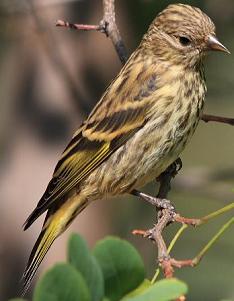Pine Siskin 
You can attract Pine Sisikin to your back yard
with water and bird seed.
Identification and Pictures
(Carduelis pinus)
Pine Sisikin are small dark finches,
about 5 inches. They have pointed conical bills, and a
deeply notched tail. The wings and tail have yellow patches.
Females and young birds appear similar to adult males; however
the males have more yellow. The contact calls as they
fly overhead in their undulating flight, are often the first
sign the birds are around.
Birds similar to Pine Siskin are House finches
and goldfinches and Common Redpoles.
Photos by Keith
Lee. The camera I use is the Canon
EOS 40D. Visit All-birds store

Sound
Their call sounds like clee-ip. They
also make a zzzz sound, and when in flight they call
tit-i-tit.
Preferred Habitat
Pine siskin can be found in much of Canada, and
the U.S. Birds in southern Canada may migrate
south. In much of northern and western U.S. they are
resident all year. They can be found in conifers, mixed
woods, and weedy fields. Pine siskins are very sociable,
and form into flocks year round. In winter the flocks
are larger, and are often mixed with other species.
Migration varies, and may depend largely on food supply.
Breeding and Nesting
Siskins pair up while in winter flocks, and
pairs are monogamous. They may nest as single pairs, or
in small colonies where nests are built adjacent to each
other. After she chooses a nesting site in conifer trees
the female builds a well hidden nest of twigs, grass, bark,
lichen, and leaves, lined with feathers, plant down, moss, and
hair. She will lay 3 to 6 pale blue eggs, and incubate
them for around 13 days. The male will bring her food
while she incubates the eggs, and both adult birds will feed
the hatchlings. After the young fledge in about 2 weeks,
the parents will feed them for around 3 more weeks. A
pair of Pine siskin may raise 2 broods in a year.
Food
Pine siskin often hanging upside down as they climb
about, foraging in trees, and shrubbery. Their
diet consists mainly of seeds, but they also eat nuts, and
insects. They will visit backyard suet, and seed feeders,
often feeding on the ground under them.

|
